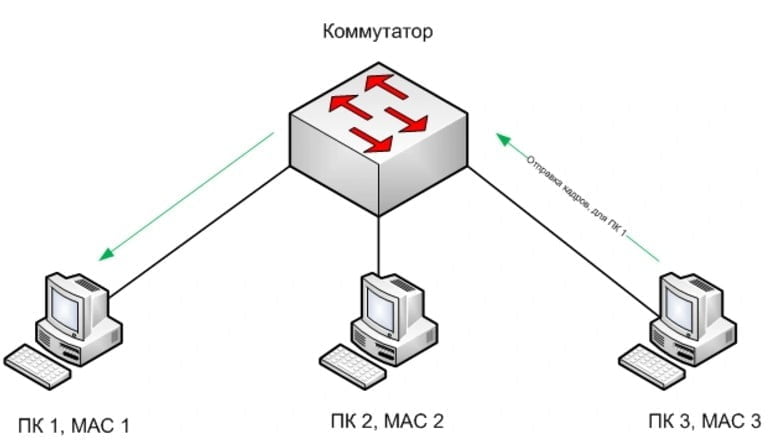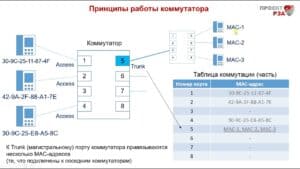- Switch: definition and main characteristics
- Differences between a switch and a router and a hub
- How the switch works: operating principle
- Unmanaged, Managed, Smart: which switch to choose
- How to properly connect a switch to the network: instructions for beginners
- Pros and cons of using a switch
- Advantages of using a switch on the network
- Disadvantages of the switch and how to eliminate them
Switch: definition and main characteristics
A switch is a device used to connect computers in a local area network. It is a more advanced version of a hub and allows data to be transferred more efficiently and securely. The main characteristics of a switch include the number of ports, throughput, and manageability. The number of ports on a switch can vary from several to several hundred, depending on its purpose and the user's needs. The throughput of a switch determines the speed of data transfer between computers and can vary from several megabits per second to several gigabits per second. Switch manageability can be simplified or advanced. Simplified manageability allows you to configure basic switch parameters, such as VLAN and Quality of Service (QoS). Advanced manageability allows you to configure more complex functions, such as Spanning Tree Protocol (STP) and Link Aggregation Control Protocol (LACP). Switches are a necessary component in any modern local area network and allow you to efficiently transfer data between computers. They also provide a high degree of security and data protection, which makes them indispensable for business-oriented networks.
Differences between a switch and a router and a hub
A switch, router, and hub are all devices that are used to connect computers into a single network. But each of them works differently.
The hub sends data to all devices on the network, which can cause congestion and slow data transfer rates.
A router is used to connect different networks, for example, to connect a home network to the Internet. It can also keep your network secure by blocking unwanted traffic.
A switch, unlike a hub, sends data only to the computer for which it is intended, which improves data transfer speed and reduces network load.
Thus, a switch is a more efficient and faster way to connect devices into one network.
How the switch works: operating principle
A switch is a network device that is used to connect several computers on a local network. The operating principle of the switch is that it receives data from one port and transmits it to the desired port where the recipient is located. Unlike a hub, a switch does not send data to all ports, but redirects it only to the port where it is addressed. This allows you to reduce network load and increase data transfer speeds. In addition, the switch has the ability to create virtual VLANs, which allow you to divide one physical network into several isolated logical networks. As a result, the switch is the basis for creating local networks of any scale and ensures stable and fast data transfer between devices.
A switch is a device used to connect computer networks. It allows you to connect several devices into one network and provides data transfer between them. A switch operates at the channel level of the OSI model and differs from a hub in that it can analyze MAC addresses and send data only to the desired device without affecting other devices on the network.
There are several types of switches: unmanaged, managed and combined. Unmanaged switches are used for small networks where it is not necessary to configure switch parameters. Managed switches allow you to configure network parameters, including VLAN and QoS. Combined switches combine the functions of unmanaged and managed switches.
When choosing a switch for your home or office, it is important to consider the number of devices that will be connected to the network, as well as the need to configure network parameters. For a small network, you can use an unmanaged switch, but for a large network with many users and devices, it is recommended to use a managed switch.
It is also important to pay attention to the data transfer speed that the switch supports. The higher the speed, the faster data will be transferred between devices on the network.
Choosing a switch for your home or office can be difficult, but choosing the right one will help ensure stable network operation and fast data transfer.
Unmanaged, Managed, Smart: which switch to choose
When choosing a switch for a network, you need to understand what type of switch is suitable for a specific task. There are three types of switches on the market: Unmanaged, Managed and Smart.
- Unmanaged switches are simple devices that do not require configuration. They are suitable for small networks where there is no need for network management and traffic control.
- Managed switches are devices that allow you to manage your network and control traffic. They are suitable for medium and large networks that require flexible network management and configuration.
- Smart switches are devices that combine the features of Unmanaged and Managed switches. They are suitable for medium-sized networks that require some traffic management and control, but not as complex as Managed switches.
When choosing a switch, you need to take into account the size of the network, requirements for managing and monitoring traffic, as well as the budget. This will help you choose the most suitable type of switch and ensure efficient network operation.
How to properly connect a switch to the network: instructions for beginners
A switch is a device that is used to connect several devices into a network. It allows you to manage data traffic, regulating its flow and directing it to the desired device. If you are just starting to work with networks, then connecting a switch may seem like a complicated process. However, with the help of these instructions you can quickly and correctly connect the switch to the network.
Step 1. Prepare the necessary components.
Before you start connecting the switch, make sure that you have all the necessary components: switch, network cable, socket and devices that need to be connected.
Step 2. Connect the switch to an outlet.
First you need to connect the switch to an outlet. To do this, take a network cable and insert one end into the port on the switch, and the other into the socket.
Step 3. Connect devices to the switch.
Now you need to connect the devices to the switch. To do this, take a network cable and connect one end to a port on the device, and the other to a port on the switch. Repeat this step for all devices you want to connect.
Step 4: Check the connection.
When all devices are connected, you need to check the network operation. To do this, run a program that allows you to check the connection (for example, Ping). If everything is connected correctly, then you should receive a response from all connected devices.
By following these instructions, you can quickly and correctly connect the switch to the network. Now you are ready to use your network!
Pros and cons of using a switch
A switch is a device used to connect multiple computers to a single network. It has several advantages, such as allowing for quick data exchange between computers, increasing internet speed, and improving network security.
However, the switch may also have some disadvantages. For example, it can be quite expensive, especially if you need a high-quality switch. Also, if you only have a few computers, then using a switch may not be practical.
In addition, the switch may not be configured correctly, which can lead to reduced network speed or even operational failures. Therefore, it is important to configure the switch correctly or seek help from specialists.
Thus, the switch has its pros and cons, and its use depends on your needs. If you have several computers and want to increase network speed and improve security, then a switch can be a useful device. However, before purchasing a switch, it is important to make sure that it suits your needs and is configured correctly.
Advantages of using a switch on the network
A switch is a device that is used to connect computers and other network devices in a local area network. One of the main advantages of using a switch is that it provides a higher data transfer rate between devices in the network. This is due to the fact that the switch uses switching technology, which allows data to be sent only to the device it is addressed to, and not to the entire network.
Another important advantage of the switch is its ability to process large amounts of data simultaneously. This allows devices on the network to operate more efficiently and improves the performance of the entire network.
In addition, the switch can be used to create virtual local networks (VLANs), which allow you to divide the network into separate segments and manage them independently of each other. This helps increase network security and simplifies network administration.
Overall, using a switch on a network has many benefits that help increase the speed and performance of the network, ensure its security, and simplify its administration.
Disadvantages of the switch and how to eliminate them
A switch is a very useful device for creating a network, but it has its drawbacks. One of the main disadvantages of a switch is the possibility of network loops. If two ports of a switch are connected to each other, a loop is created, which can lead to a failure in the network.
To overcome this shortcoming, it is necessary to use the Spanning Tree protocol. It allows you to find and block ports that create loops in your network. It is also important to configure the switch ports correctly to avoid creating loops.
Another disadvantage of the switch is the possibility of attack through its ports. If the switch port is not protected, then an attacker can gain unauthorized access to the network. To secure ports, you must use protocols such as Port Security or 802.
1X.
Also, a switch can become a bottleneck in the network if its performance does not meet the requirements. In this case, you need to use a switch with higher performance or add another switch to distribute the load.
In general, a switch is a very useful device for creating a network, but it is necessary to take into account its shortcomings and take measures to eliminate them.
Read further:






